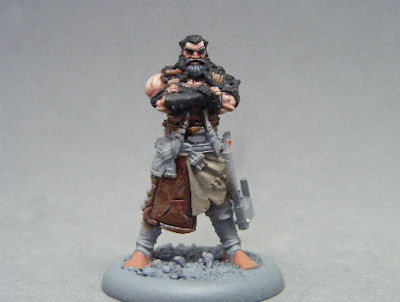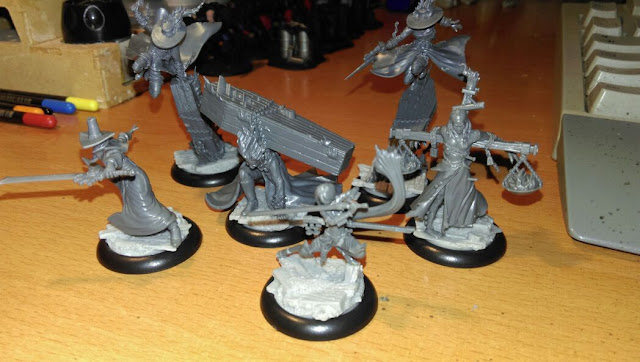Big Papa has started painting his new Age of Sigmar figures, and when posting them on Twitter, there has been quite a lot of interest in how the stone was painted.
So here is Big Papa'a guide to painting stone.
Step 1: Prime the model black. If you are spraying the primer on, check for any areas the spray has missed after the first coat has dried. Use a brush and some black paint to fill in those areas, and let everything dry thoroughly before moving on to the next step.
 |
| Step 1 |
Step 2: Drybrush your model with a dark brown paint. "Burnt umber" is the artist/craft paint equivalent. I used "Orc Flesh" from the now defunct Leviathan range.
A few notes about your choice of brush here: I like to use a softer bristled brush, which I think provides better coverage, and a less scratchy finish than some of the harsher brushes. Also, in this instance, you can get away with using the same brush for all of the drybrushing stages. You may need to go over the model twice or more to get the final colour, but the mixing of the different paints in the bristles of the brush give what I consider to be a pleasing transitional tone to the highlighting.
A few notes about your choice of brush here: I like to use a softer bristled brush, which I think provides better coverage, and a less scratchy finish than some of the harsher brushes. Also, in this instance, you can get away with using the same brush for all of the drybrushing stages. You may need to go over the model twice or more to get the final colour, but the mixing of the different paints in the bristles of the brush give what I consider to be a pleasing transitional tone to the highlighting.
 |
| Step 2 |
Step 3: Drybrush your model with the equivalent of the old GW foundation paint, "Charadon Granite". I've yet to find a proper non-GW equivalent for this paint, but a mixture of grey, black and muted brown and green paints can make something very similar.
 |
| Step 3 |
Step 4: Time to drybrush with a nice mid grey colour. I've used Inscribe "Dark Ghost Flat"
You should be making gentler passes with each successive drybrush, so that the previous colour shows through a bit. I find it helps to hold my brush further up the handle, further away from the bristles for each pass. Maybe that'll work for you too, maybe not. To each, their own.
You should be making gentler passes with each successive drybrush, so that the previous colour shows through a bit. I find it helps to hold my brush further up the handle, further away from the bristles for each pass. Maybe that'll work for you too, maybe not. To each, their own.
 |
| Step 4 |
Step 5: Okay, this is the last bit of drybrushing. Use a light grey paint to drybrush on the final highlights. I've used "Morning Mist Grey" from Decoart, but any light grey will do. The closest equivalent to the paint I used is probably the old GW "Astronomican Grey" foundation paint (or if your memories stretch even further back, "Fortress Grey").
 |
| Step 5 |
Step 6: This is an optional step. I like to get a fine detail brush, and use a bit of the light grey paint to emphasize some of the edges on the model, and provide definition, This is most obvious on the chest of this model.
 |
| Step 6 |
Step 7: Use a very fine brush, and some thinned down "Charadon Granite" to carefully draw cracks onto the model.
I find the most effective way to draw these is often to make a series of interconnected 'Y' shapes moving in a diagonal direction. Think of lightning, and you'll not go far wrong. Don't forget to add a couple of small nicks and chips to add a bit of realism, and don't be shy of drawing cracks over raised details, like the hammer detail on the shield.
I find the most effective way to draw these is often to make a series of interconnected 'Y' shapes moving in a diagonal direction. Think of lightning, and you'll not go far wrong. Don't forget to add a couple of small nicks and chips to add a bit of realism, and don't be shy of drawing cracks over raised details, like the hammer detail on the shield.
 |
| Step 7 |
Step 8: Underlight' the cracks you have just painted so carefully onto your model. Use a fine brush, and some off-white colour paint (in my case, "Storm Cloud" by Docrafts, but you can always add a bit of white to a light grey paint, or even just use white). I break this rule a lot, for the sake of aesthetics, so don't be afraid to do what looks best to you, but the general rule is to imagine where the light is coming from on your model, and highlight the edge that would be furthest away from it.
For example, we often paint models as if the light is coming from above. So we apply highlights to the top edges of armour/weapons etc. In this case, we're looking to highlight the lower egdes instead.
For example, we often paint models as if the light is coming from above. So we apply highlights to the top edges of armour/weapons etc. In this case, we're looking to highlight the lower egdes instead.
 |
| Step 8 |
Step 9: Your stone effects are now done. Hurrah! I've added an extra picture of the shield on this Liberator, as I thought it may help illustrate the underlighting a bit better than my writing in the last step.
 |
| Step 9 |








































